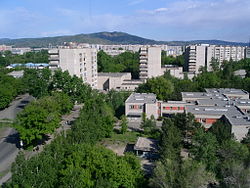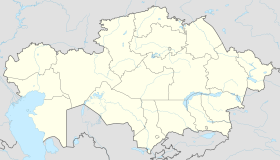Oskemen
|
Öskemen / Ust-Kamenogorsk Өскемен (Kazakh) / Усть-Каменогорск (Russian) |
|||
|---|---|---|---|
 |
|||
|
|||
| Location in Kazakhstan | |||
| Coordinates: 49°59′N 82°37′E / 49.983°N 82.617°E | |||
| Country | Kazakhstan | ||
| Region | East Kazakhstan Region | ||
| Founded | 1720 | ||
| Incorporated (city) | 1868 | ||
| Government | |||
| • Akim (mayor) | hjmgmghm | ||
| Area | |||
| • Total | 540 km2 (210 sq mi) | ||
| Elevation | 283 m (928 ft) | ||
| Population (2013) | |||
| • Total | 321,251 | ||
| • Density | 590/km2 (1,500/sq mi) | ||
| Time zone | ALMT (UTC+6) | ||
| Postal code | 070000–070019 | ||
| Area code(s) | +7 7232 | ||
| Vehicle registration | F, 16 | ||
| Website | www |
||
Oskemen (Kazakh: Өскемен/Öskemen, ؤسكەمەن) or Ust-Kamenogorsk (Russian: Усть-Каменого́рск) is the administrative center of East Kazakhstan Region of Kazakhstan. It is served by Oskemen Airport. Population: 303,720 (2009 Census results); 310,950 (1999 Census results).
The city has two official names. In the Kazakh language accepted name Өскемен/Öskemen, in Russian - Усть-Каменогорск. Both names are imaged on the seal of the city. In English used both Oskemen and Ust-Kamenogorsk.
The city was founded in 1720 at the confluence of the Irtysh and Ulba rivers as a fort and trading post named Ust-Kamennaya. It was established according to the order of the Russian Emperor Peter the Great, who sent a military expedition headed by major Ivan Vasilievich Likharev in the search of Yarkenda gold. Likharev’s expedition directed up the Irtysh river to Zaysan Lake. There, at the confluence of the Ulba and the Irtysh rivers the new fortress was laid – the Ust-Kamennaya Fortress. The Ust-Kamennaya Fortress appeared on the map of the Russian Empire, the very southern end of the Irtysh line. In 1868 the city became the capital of the Semipalatinsk Oblast. It was the site of Georgy Malenkov's 30-year internal exile, during which he managed a local hydroelectric plant.
The city developed into a major mining and metallurgical center during the Soviet period. Mining of non-ferrous metals, especially uranium, beryllium, tantalum, copper, lead, silver and zinc remain important. It is a center for the construction industry producing manufactured housing and ferroconcrete articles. The post-war industrial history of the city is very closely intertwined with the Soviet nuclear bomb project, and the city was therefore kept closed to outsiders. One of the main industrial enterprises, the Ulba Metal Works (UMW) which produced and still produce uranium products, was kept entirely secret despite it employing thousands of workers. An explosion at the UMW's beryllium production line in 1990 led to the diffusion of a highly toxic beryllium-containing "cloud" over the city. The health effects of this incident are not entirely known, partly because the incident was kept secret by the Soviet authorities. Kazakhs who have visited the city state it is highly polluted which has led to alarmingly high cancer rates (as of 2014[update]).
...
Wikipedia



